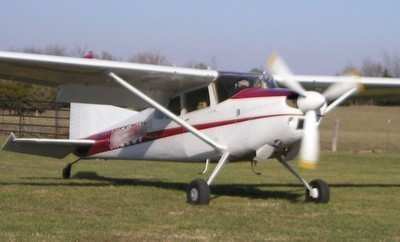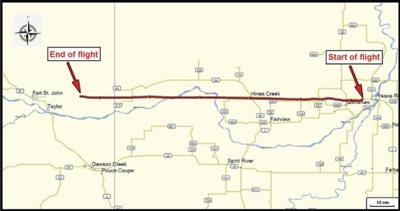Canadian Pilot Received Text Messages And Spent Nearly Half An Hour On The Phone While Flying
The Canadian Transportation Safety Board has release its final report in a fatal accident which occurred on November 30th of last year in which a pilot flying a Cessna 185E (similar airplane pictured in file photo) flew into the ground, resulting in his fatal injury.

The pilot had departed St. John Airport in British Columbia, Canada, in the morning, flying to Peace River Airport in Alberta and then on to Fort Vermilion airport, also in Alberta. On his return flight, which took place under night VFR conditions, "the pilot engaged in 2 text message exchanges and conducted 5 voice cell phone communications totalling 28 minutes. The pilot received a final text message at 1806, 11 minutes before the accident."
According to the report, the accident aircraft was a Cessna 185E. The aircraft had been in service with Trek Aerial Surveys since January 2010 and was equipped for day and night VFR operations. The aircraft was not, nor was it required to be, equipped with a flight data recorder (FDR), cockpit voice recorder (CVR), terrain awareness warning systems (TAWS) or an autopilot. The aircraft, at the time of the occurrence, was maintained in accordance with the existing regulations. No outstanding defects had been reported.
The pilot held a commercial pilot license and was qualified in accordance with the regulations existing at the time of the occurrence. The pilot had accumulated approximately 2170 hours of flight time with about 182 hours on the accident aircraft. The pilot had completed recurrent training outside of the company to renew a multi–engine instrument rating on 25 November 2011. It could not be determined how many hours of night flying experience the pilot had, beyond that required for the issuance of the commercial pilot license.

In the report, the TSB says "In the events leading up to this occurrence the aircraft experienced several large altitude deviations while the pilot was using the cellphone. Cell phone use can distract operators from essential operational tasks. There have been no comprehensive studies regarding the use of cell phones as a distraction in an aviation context. The phenomenon has, however, been extensively studied in the automotive sector. The Canadian Council of Motor Transport Administrators defines driver distraction:
"Distracted driving is the diversion of attention from driving, as a result of the driver focusing on a non–driving object, activity, event or person. This diversion reduces awareness, decision–making or performance leading to increased risk of driver error, near–crashes or crashes. The diversion of attention is not attributed to a medical condition, alcohol/drug use and/or fatigue."
The board said that "while it did not appear that the pilot was actively engaged in cell phone communications during the last 11 minutes of the flight, this distraction was prevalent throughout the flight and in conjunction with the night conditions encountered, may have contributed to the CFIT event."
The board concluded that "(f)or undetermined reasons, the pilot descended too low or was not aware of the descent and low altitude of the aircraft, which resulted in an impact with terrain.
"Pilots who engage in non–essential text and voice cell phone communications while conducting flight operations may be distracted from flying the aircraft, placing crew and passengers at risk.
"When cockpit or data recordings are not available to an investigation, this may preclude the identification and communication of safety deficiencies to advance transportation safety."
(Route of flight map provided by the Canadian Transportation Safety Board)
 Airborne 05.10.24: Icon Auction, Drunk MedEvac Pilot, Bell ALFA
Airborne 05.10.24: Icon Auction, Drunk MedEvac Pilot, Bell ALFA ANN's Daily Aero-Term (05.13.24): ILS PRM Approach
ANN's Daily Aero-Term (05.13.24): ILS PRM Approach ANN's Daily Aero-Linx (05.13.24)
ANN's Daily Aero-Linx (05.13.24) Airborne-NextGen 05.07.24: AI-Piloted F-16, AgEagle, 1st 2 WorldView Sats
Airborne-NextGen 05.07.24: AI-Piloted F-16, AgEagle, 1st 2 WorldView Sats Airborne 05.08.24: Denali Update, Dad-Daughter Gyro, Lake SAIB
Airborne 05.08.24: Denali Update, Dad-Daughter Gyro, Lake SAIB




